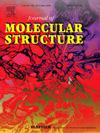Inflated electronic and optical assessment of gC3N4/ZnO nanocomposite as a potential emissive layer material for OLED application
IF 4
2区 化学
Q2 CHEMISTRY, PHYSICAL
引用次数: 0
Abstract
Organo-inorganic nanocomposite materials have been proven to be novel hybrid materials with inflated electronic and optical performance that can be tailored with the judicious selection of the building units or their combinations. Here, hydrothermal, thermal polycondensation, and ultrasonication techniques were used to synthesize pure ZnO, gC3N4, and gC3N4/ZnO with varying weights % such as 10 %, 15 %, 20 %, and 25 % of ZnO inorganic filler elements in gC3N4 matrix. The crystalline phase (hexagonal wurtzite) and crystallite size (10.0 nm, 17.6 nm, and 15.90 nm) of the synthesized materials were examined by X-ray diffractometer. The FESEM and HRTEM characterizations revealed the sheet-like gC3N4 and spherical-type ZnO nanoparticle-like microstructures of the samples. The present functional groups, corresponding vibrational frequency, chemical states, and binding energy were investigated using FTIR and XPS spectroscopic methods. Optical parameters such as optical band gap energy (Eg = 3.24 eV), Urbach energy (Eu = 0.41 eV), refractive index (n = 1.99), emission quantum yield (∼ 69.03 %), and color purity of the nanocomposites were examined using UV visible and photoluminescence spectroscopic techniques. IV and Hall measurements techniques were used to determine the semiconducting parameters of the optimized sample, such as conductivity (∼62.90×10−5 S/cm), carrier mobility (∼ 44.1 cm2/Volt. Sce), carrier concentrations (∼1.825×1014 cm−3), and sheet resistance (∼1.062×103 Ω/cm2). Due to their excellent optical and electrical behavior, the nanocomposite materials were found to be fairly suitable as a potential emissive layer material for OLED applications.
将 gC3N4/ZnO 纳米复合材料作为 OLED 应用的潜在发射层材料进行膨胀电子和光学评估
有机-无机纳米复合材料已被证明是一种新型的混合材料,具有极高的电子和光学性能,可通过明智地选择构建单元或其组合来定制。本文采用水热法、热缩聚法和超声法合成了纯 ZnO、gC3N4 和 gC3N4/ZnO,其中 gC3N4 基体中的 ZnO 无机填充元素的重量百分比各不相同,如 10%、15%、20% 和 25%。用 X 射线衍射仪检测了合成材料的结晶相(六方涡晶)和结晶尺寸(10.0 nm、17.6 nm 和 15.90 nm)。FESEM 和 HRTEM 表征显示样品具有片状 gC3N4 和球状 ZnO 纳米粒子的微观结构。利用傅立叶变换红外光谱和 XPS 光谱方法研究了存在的官能团、相应的振动频率、化学状态和结合能。利用紫外可见光和光致发光光谱技术检测了纳米复合材料的光学参数,如光学带隙能(Eg = 3.24 eV)、厄巴赫能(Eu = 0.41 eV)、折射率(n = 1.99)、发射量子产率(∼ 69.03 %)和颜色纯度。利用 IV 和霍尔测量技术确定了优化样品的半导体参数,如电导率(∼62.90×10-5 S/cm)、载流子迁移率(∼44.1 cm2/Volt.Sce)、载流子浓度(∼1.825×1014 cm-3)和薄层电阻(∼1.062×103 Ω/cm2)。由于纳米复合材料具有优异的光学和电学性能,因此非常适合作为潜在的发光层材料用于有机发光二极管应用。
本文章由计算机程序翻译,如有差异,请以英文原文为准。
求助全文
约1分钟内获得全文
求助全文
来源期刊

Journal of Molecular Structure
化学-物理化学
CiteScore
7.10
自引率
15.80%
发文量
2384
审稿时长
45 days
期刊介绍:
The Journal of Molecular Structure is dedicated to the publication of full-length articles and review papers, providing important new structural information on all types of chemical species including:
• Stable and unstable molecules in all types of environments (vapour, molecular beam, liquid, solution, liquid crystal, solid state, matrix-isolated, surface-absorbed etc.)
• Chemical intermediates
• Molecules in excited states
• Biological molecules
• Polymers.
The methods used may include any combination of spectroscopic and non-spectroscopic techniques, for example:
• Infrared spectroscopy (mid, far, near)
• Raman spectroscopy and non-linear Raman methods (CARS, etc.)
• Electronic absorption spectroscopy
• Optical rotatory dispersion and circular dichroism
• Fluorescence and phosphorescence techniques
• Electron spectroscopies (PES, XPS), EXAFS, etc.
• Microwave spectroscopy
• Electron diffraction
• NMR and ESR spectroscopies
• Mössbauer spectroscopy
• X-ray crystallography
• Charge Density Analyses
• Computational Studies (supplementing experimental methods)
We encourage publications combining theoretical and experimental approaches. The structural insights gained by the studies should be correlated with the properties, activity and/ or reactivity of the molecule under investigation and the relevance of this molecule and its implications should be discussed.
 求助内容:
求助内容: 应助结果提醒方式:
应助结果提醒方式:


